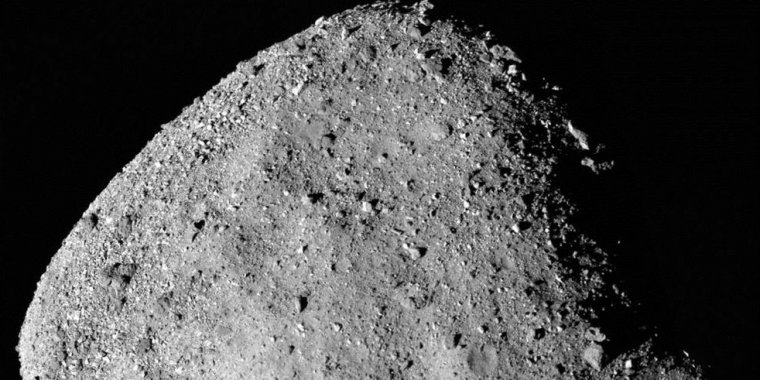| News / Space News |
NASA’s OSIRIS-REx Spacecraft Discovers Water on Asteroid
Recently analyzed data from NASA’s Origins, Spectral Interpretation, Resource Identification, Security-Regolith Explorer (OSIRIS-REx) mission has revealed water locked inside the clays that make up its scientific target, the asteroid Bennu.

Asteroid Bennu. [Credits: NASA/Goddard/University of Arizona
During the mission’s approach phase, between mid-August and early December, the spacecraft traveled 1.4 million miles (2.2 million km) on its journey from Earth to arrive at a location 12 miles (19 km) from Bennu on Dec. 3.
Data obtained from the spacecraft’s two spectrometers, the OSIRIS-REx Visible and Infrared Spectrometer (OVIRS) and the OSIRIS-REx Thermal Emission Spectrometer (OTES), reveal the presence of molecules that contain oxygen and hydrogen atoms bonded together, known as “hydroxyls.”
The team suspects that these hydroxyl groups exist globally across the asteroid in water-bearing clay minerals, meaning that at some point, Bennu’s rocky material interacted with water. While Bennu itself is too small to have ever hosted liquid water, the finding does indicate that liquid water was present at some time on Bennu’s parent body, a much larger asteroid.
Additionally, data obtained from the OSIRIS-REx Camera Suite (OCAMS) corroborate ground-based telescopic observations of Bennu and confirm the original model. That model closely predicted the asteroid’s actual shape, with Bennu’s diameter, rotation rate, inclination, and overall shape presented almost exactly as projected.
One outlier from the predicted shape model is the size of the large boulder near Bennu’s south pole. The ground-based shape model calculated this boulder to be at least 33 feet (10 meters) in height. Preliminary calculations from OCAMS observations show that the boulder is closer to 164 feet (50 meters) in height, with a width of approximately 180 feet (55 meters).
Bennu’s surface material is a mix of very rocky, boulder-filled regions and a few relatively smooth regions that lack boulders. However, the quantity of boulders on the surface is higher than expected. The team will make further observations at closer ranges to more accurately assess where a sample can be taken on Bennu to later be returned to Earth.
The mission currently is performing a preliminary survey of the asteroid, flying the spacecraft in passes over Bennu’s north pole, equator, and south pole at ranges as close as 4.4 miles (7 km) to better determine the asteroid’s mass.
The spacecraft’s first orbital insertion is scheduled for Dec. 31, and OSIRIS-REx will remain in orbit until mid-February 2019, when it exits to initiate another series of flybys for the next survey phase.
During the first orbital phase, the spacecraft will orbit the asteroid at a range of 0.9 miles (1.4 km) to 1.24 miles (2.0 km) from the center of Bennu — setting new records for the smallest body ever orbited by a spacecraft and the closest orbit of a planetary body by any spacecraft. (NASA)
YOU MAY ALSO LIKE



